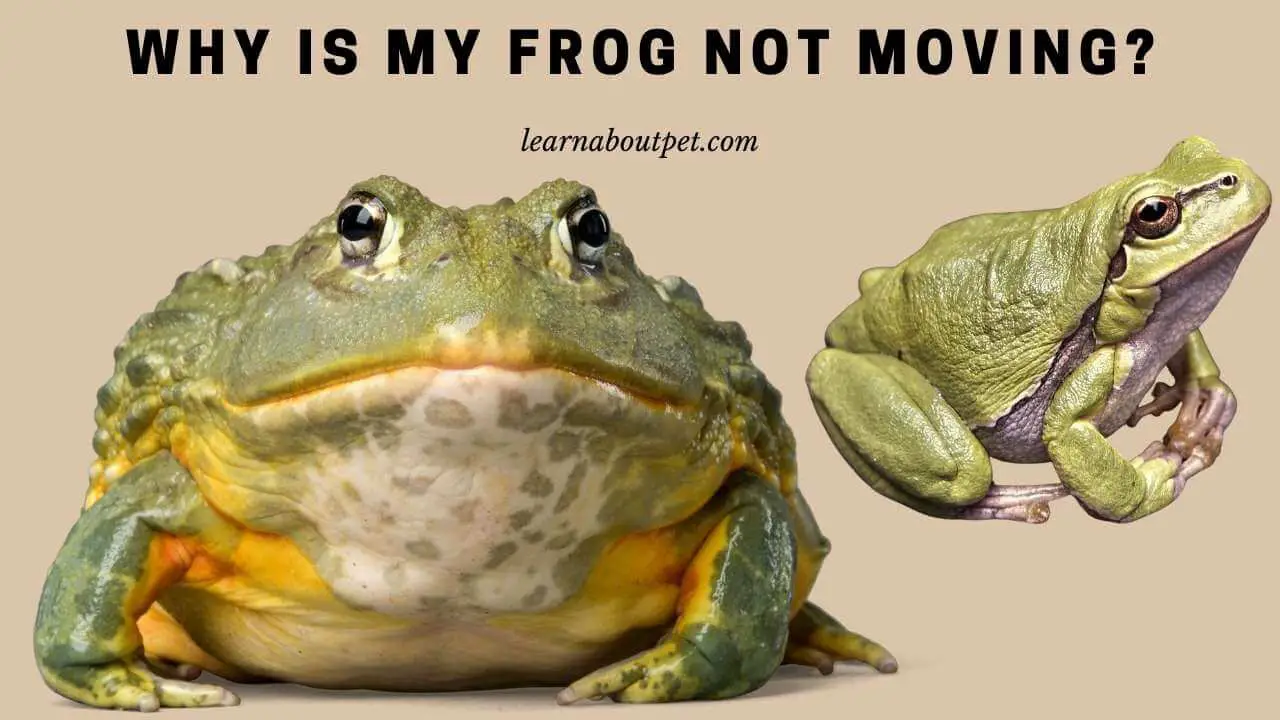Noticing that your frog is not moving can cause you, as a pet frog owner, a great deal of distress. You are bound to have questions like why are frogs not moving, could he be dying, what can I do about it… and so on. In this article, we will be addressing those concerns.
Why is my frog not moving? One of the best ways to help a frog that is not moving is by having him soak in de-chlorinated water. The aim is to energize the frog. You only need to be sure that the frog is not near a place where drafts can occur. Before using your bare hand to transfer your frog to the soak water, ensure that you wash them with a mild cleanser. Dry them and re-rinse with de-chlorinated water.

The de-chlorinated water you use to soak the frog (with a view to energize him) should have several drops of honey added to it. So you just obtain de-chlorinated water. You add several drops of honey to it. Then you transfer the frog to that water, and let him soak in it, in order to (hopefully) energize him.
Why is My Frog Not Moving?
There are several possible reasons why your frog is not moving. It could be that the temperature conditions are not ideal for him. It could be that he is stressed, or in hibernation mode. Or it could be that he is hungry. Further, it could be a sign that he is ill. Or it could be that he is suffering a seizure.
More ominously, your frog not moving could be a sign that he is dying. Or it could be a sign that the frog is actually already dead.
Typically, when a person poses the question on why is my frog not moving, the key concern is whether the frog is dead. So we can rephrase the question as my frog not moving is it dead? This is therefore where you need to start: by establishing whether the frog that is not moving is still alive or dead. That you can do by checking whether he is still breathing.
If the frog is still breathing, he is alive (but not necessarily well).
Another way to establish whether the frog is alive is by putting several flies (or crickets) in front of him. So you just dust several flies. Then you put them in front of the frog. If the frog reacts to the sight/smell of the flies, you know that he is still alive. Another way is by nudging him. If he responds to the nudge (even slightly), you know that he is still alive.
Even if the frog appears to be dead, you still need to ascertain this for sure: knowing that these creatures are known to play dead. So you want to be sure that he is actually dead, and not just playing dead.
What is Wrong With My Frog?
The question on why is my frog not moving is typically followed by another one – as to what is wrong with my frog. Figuring out what exactly is wrong with a frog that is not moving can be a challenging undertaking.
The first question to ask yourself is as to how long the frog has not been moving. Take a case of a frog not moving for just a few hours. That would surely be very different from a case of a frog not moving for days.
Further, in figuring out what is wrong with a frog that is not moving, you need to consider feeding habits. Has the frog been feeding normally? Take a case where you have a frog who is not moving, and he has also not been feeding normally. This could be an indication that something is seriously wrong with him.
Another important consideration is on the frog’s stress levels. For instance, is the frog is in usual environment or is he in a new environment? If he is in a new environment, it could be just that he has not acclimatized to it. Or if he is in his usual environment, but there have been major changes in it, he could be under stress.
All said and done, there may not be anything wrong with the frog. Sometimes, they could be really active climbing walls and other times they may even play dead. It may be just that the environment is not conducive to him moving. But it could also be that there is indeed something wrong with the frog. He could, in a nutshell, be stressed, ill, dying or dead.
Why is My African Dwarf Frog Not Moving?
One possibility is that the frog is unwell. If he is not moving, and there have been skin color changes, it could mean he is unwell. Similarly, if he is not moving, and also not feeding, it could mean he is unwell.
Another possibility is that the environmental conditions have changed in a manner that affects him adversely. May be the temperature has become too high. Or water conditions have become un-conducive. Or if he is a newly acquired ADF, he could still be under stress from the new environment.
To know for sure why your African Dwarf Frog is not moving, you need to ask yourself several other questions. Firstly, for how long has he not been moving? Secondly, have there been changes in his feeding habits? Thirdly, have there been skin color changes (besides the usual skin shedding)? Fourthly, have there been environmental changes?
Once you figure out why your African Dwarf Frog is not moving, you can be in a position to come up with strategies to get him moving again. Sometimes, it could be something as simple as changing the water in his bowl. At other times, it could be something as complex as trying to treat chytrid fungal infection.
Why is My Pacman Frog Not Moving?
There are many possible reasons for your Pacman frog not moving. Anyone who asks the question on why is my frog not moving is advised to first check whether the frog is alive or not. If the frog is alive, but not moving, the most important thing is to be sure that he is not ill. If there are no signs of illness, you need to consider whether there are environmental stressors.
Pacmans are known to sometimes stop moving for no apparent reasons. But if he is not moving for really long periods of time, there is reason for concern.
Why is My Tree Frog Not Moving?
In the best case scenario, it could be that your tree frog is only resting. This would mean that you have nothing to worry about. In the worst case scenario, it could be that your tree frog is dying or already dead. In between are other possibilities, like that of the tree frog being ill, under stress or malnourished.
Anyone who poses the question on why is my frog not moving is always advised to examine the frog carefully. Check whether its skin color is changing. Check whether there is bloating on the frog. And check whether the frog is reacting normally to stimuli. Only then can you get hints on whether or not your frog’s lack of movement is due to a benign reason.
Why is My Red Eyed Tree Frog Not Moving?
There is a chance that he is unwell, and that is making it hard for him to move. There is also a chance that he is uncomfortable (for instance, with the temperature), and that is making it hard for him to move.
If he is unwell, you need to try to identify what he is suffering from. Then try to get treatment for that condition (if possible). If he is uncomfortable, you need to identify what is making him uncomfortable. Then change the conditions, to make him start moving again. Even if he seems to be hibernating, the solution would be to raise temperatures to a level where hibernation is not necessary.
By the way, that strategy is useful for anyone who poses the question on why is my frog not moving (even if it is not a red eyed tree frog). So you first establish whether it is due to illness or discomfort/stress. Then if it is illness, you try to treat it – as well as you can. If it is discomfort/stress, you try to change the conditions causing it.
Why is My Green Tree Frog Not Moving?
If your green tree frog is not moving for just a few hours, you needn’t worry too much. But if your green tree frog is not moving for longer periods of time, there is reason for concern. There could be a disease which is causing him mobility problems. Or it could be that you are keeping in conditions that stress him so much that he stops moving.
Therefore, just like anyone who poses the question on why is my frog not moving, there are two things you need to do. Firstly, try to accurately establish why your green tree frog is not moving. The secondly, figure out what you can do about it.
Common Reasons for Frog Not Moving
- Disease
- Environmental stress
- Hibernation
- Malnutrition
- Death

How Do You Know if a Frog is Dying?
The key things to check are the frog’s eating habits, its skin and its movement. That is mainly how to tell if a frog is dying.
Regarding the frog’s eating habits, the frog may get to a point where he is not eating at all, for very long periods of time. With regard to skin, it may turn pale and become tattered. With regard to movement, you may have a situation of frog not moving in pond – especially where they most seem to prefer floating on the pond’s or tank’s surface.
It may eventually get to a point where the frog can’t respond to stimuli, such as nudging.
Most of the people who raise the question on why is my frog not moving want to know if it is dying. In some cases indeed, a frog not moving could be a sign that it is dying. But there are also cases where a frog not moving doesn’t necessarily mean that it is dying. The key consideration is on what other signs (besides non-movement) the frog is manifesting.
How Do You Save a Dying From?
One approach is by trying to treat whatever illness seems to be killing the frog. Another approach is improving the frog’s living conditions. The latter approach would be ideal in situation where poor living conditions seem to be what is killing the frog. That really is the most straightforward way to answer the question on how to save a frog from dying.
What Should I Do if My Frog is Not Moving?
The first step is to try to figure out why the frog is not moving. Only after answering the question on why is my frog not moving would I know what to do next.
After figuring out why the frog is not moving, you will know what the appropriate steps to take are. If the frog is sick for instance, try to treat the illness. Or at least create conditions that promote faster natural healing. If the frog is simply experiencing discomfort, try to relieve it.
My Skinny Frog is Not Moving, Now What?
Sometimes, you may just need to give him some time – to see if he will start moving again by himself. Or you may change the environmental conditions that are making him not move.
That is if you figure out environmental conditions (for instance, with regard to temperatures or humidity) are making the frog not move. Further still, you could have the frog treated. That is if you figure out that it is an illness that is making him not move.
Is My Frog Dead or Hibernating?
One way to tell is by checking the frog’s throat for breathing. In a hibernating frog there will be regular – if subtle – throat movement as it breathes. Another way is by checking the frog’s posture. For instance, if the frog is lying spread eagled with the belly up, it is probably dead and not hibernating.
Further, if the frog has skin that is dry and shell-like is probably hibernating. But if it has peeled off tattered skin, it could be dead. Of course, if the frog starts to smell and rot off, it is probably dead, and not hibernating.
Do Frogs Play Dead?
Yes, frogs do play dead. This is why you need to examine a frog closely, before declaring it dead. You could have a frog that is not moving, not responding to nudges, and apparently not breathing: but still alive!
How Long Do Frogs Play Dead?
Frogs can stay in conditions where they appear to be genuinely dead for as many as several minutes at a stretch.
Final Verdict – Why is My Frog Not Moving?
Why is my frog not moving? At best, your frog could just be resting. At worst, your frog could be dead or dying. In between are other possibilities, like those of your frog being under stressful conditions or being ill.

The best you can do is try to establish exactly why your frog is not moving. Then do all you can to eliminate the conditions that are making your frog not move: so that it can start moving happily again.

Welcome to Learn About Pet. My name is Rajkumar Ravichandran and I love all pets, travel, and amazing food. I write about my passion and personal experience caring for multiple pets in this blog! ❤️
Post Disclaimer
DISCLAIMER: THIS BLOG OR WEBSITE, "Learn About Pet", DOES NOT PROVIDE YOU WITH MEDICAL ADVICE AND IS NOT A SUBSTITUTE FOR MEDICAL ADVICE. ALWAYS GET IN TOUCH WITH YOUR PERSONAL VETERINARIAN AND USE INFORMATION HERE AS GENERAL ADVICE.
The information, including but not limited to, text, graphics, images and other material contained on this website are for informational purposes only. No material on this site is intended to be a substitute for professional veterinary advice, food recommendation, diagnosis, or treatment. Always seek the advice of your veterinarian or other qualified health care provider with any questions you may have regarding a medical condition or for pet food related questions.







